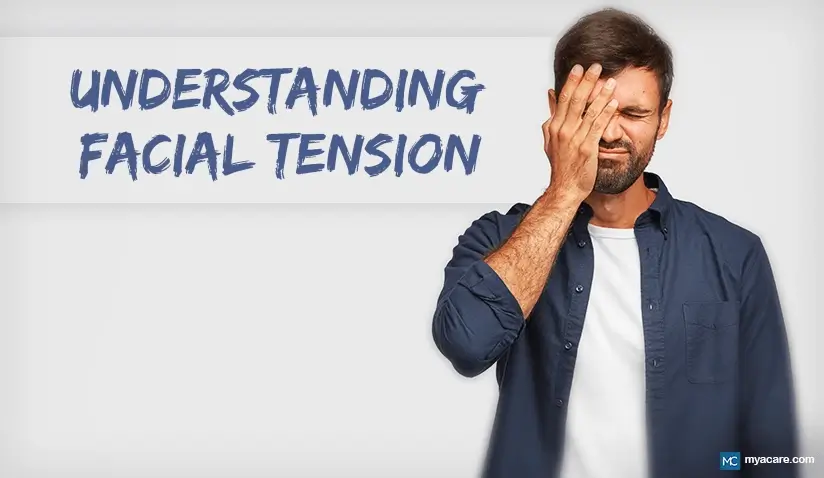Understanding Facial Tension: Causes and Solutions

Medically Reviewed and Updated by Dr. Rae Osborn, Ph.D. - August 27, 2024
Facial tension is a common problem that many people experience, yet it often goes unnoticed or ignored. It can manifest in various ways, such as jaw pain, headaches, and neck pain, and can have a significant impact on daily life.
In this article, we will explore the causes of facial tension and provide solutions for reducing and managing it.
What is Facial Tension?
Facial tension is the feeling of tightness or discomfort in the muscles of the face, jaw, and neck.
It can have a variety of causes, such as poor posture, muscle tension, and stress. When left untreated, facial muscle tension can lead to chronic pain that affects daily activities and overall well-being.
Symptoms of Facial Tension
Facial tension can manifest in various ways, and the symptoms may vary from person to person.
Some common symptoms of facial tension include:
- Jaw and neck pain
- Redness in the face
- Headaches, particularly tension headaches. These can be episodic or chronic.
- Facial pain, tingling or discomfort
- Tightness in the face or neck muscles
- Diminished range of motion in the neck and jaw
- Eye strain and tension, which can be due to spending too much time on digital devices.[1]
- Clenching the jaw
- Grinding teeth, especially at night
There are also a handful of dated studies suggesting that facial tension can affect breathing and contribute to asthma.
Causes of Facial Tension
Several common causes of facial tension include:
- Stress: Stress and anxiety[2] can affect the muscles in your face. Our muscles tend to tighten when we are stressed, leading to tension in the face and neck.
- Poor Posture: Slouching or hunching can place strain on the muscles in the face and neck, leading to tension.
- Muscle Tension: Muscle overuse, injury, or underlying medical conditions can cause too much tension.
- Muscle Knots: Muscle tension in the jaw, neck, and shoulders can develop into muscle knots, causing further discomfort.
- Tension Headaches: These are a common type of headache that can cause facial tension, as well as pain in the neck and shoulders.
- Zoom Fatigue: The rise of remote work and virtual meetings, especially when coupled with poor posture, are other causative factors.
- Bruxism: The habit of grinding or clenching teeth. It can contribute to facial tension by putting strain on the jaw and causing pain.
Facial tension can also arise due to chronic disorders such as myofascial pain or a Temporomandibular Joint Disorder.
Myofascial Pain
Myofascial pain is a long-lasting and persistent chronic condition that can affect all ages. It is characterized by recurring muscle pain and constant tension, frequently localized in the facial and neck regions. Myofascial pain can be caused by muscle overuse, muscle microtrauma, injury, or underlying medical conditions. Aging and vascular changes can increase the risk.[3]
This condition can significantly affect a person's quality of life. Even simple tasks such as speaking or eating can be quite challenging and uncomfortable. A constant sense of tightness and discomfort is often experienced alongside sporadic episodes of intense pain. If left untreated, it can last for weeks, months, or even years.
Temporomandibular Joint Disorders
TMJ disorders are complex ailments that affect the intricate joint connecting the jawbone to the skull. They can be caused by factors such as jaw injury, arthritis, or teeth grinding. It is estimated that 5-12% of the population are affected.[4]
This condition can trigger a range of distressing symptoms, including but not limited to
- Debilitating facial tension and stiffness
- Excruciating jaw pain
- Difficulties while chewing or speaking
- Frequently occurring headaches
- Facial twitching or muscle spasms, in unusual cases[5] [6]
- Disruptions to daily life
- Difficulty carrying out routine activities
- Affects overall mood and well-being
The duration of TMJ disorders can vary, but with proper treatment and management, symptoms can improve over time. Some may require surgery to treat their TMJ disorder.
Diagnosis
For infrequent facial tension, home care may be enough to alleviate the condition. However, the diagnosis and treatment of chronic or episodic facial tension typically involves a thorough evaluation by a maxillofacial specialist. Sometimes, a dentist or orthodontist can diagnose facial tension if it relates to misalignment of the jaw or bruxism.
A specialist may conduct a physical exam, review medical history, and order diagnostic tests like X-rays or MRI scans. The physical symptoms tend to guide the physical exam, leading to the cause:
- For TMJ disorders, the condition of the temporomandibular joint (TMJ) and surrounding muscles is assessed.
- To diagnose myofascial tension, overall facial tension, muscle knots, tenderness, and trigger points will be evaluated.
It is important to note that TMJDs and myofascial tension can sometimes coexist.
By diagnosing the underlying cause, healthcare professionals can develop an apt treatment plan to alleviate symptoms.
Solutions for Reducing Facial Tension
Fortunately, there are several effective solutions for reducing and managing facial tension. These include:
Deep Breathing Exercises
Deep breathing exercises can be helpful to relax the muscles in the face and neck, reducing tension and promoting relaxation.
To perform these exercises, get into a comfortable position, either seated or lying down. Take large, immersive breaths that fill your lungs deeply with air, and then slowly exhale.
You can also try incorporating meditation or mindfulness techniques into your deep breathing exercises for added relaxation.
Facial Exercises
Facial exercises can aid in strengthening the muscles in the face, thereby reducing injury risk and promoting overall facial health. Some simple facial exercises you can try include:
- Jaw stretches: Start by opening your mouth as wide as possible, then close it slowly, feeling the stretch in your jaw muscles.
- Cheek stretches: Smile as wide as possible, then slowly relax your face, feeling the stretch in your cheek muscles.
- Eye and forehead stretches: Raise your eyebrows as high as you can. Then, slowly relax your face, feeling the stretch in your forehead and eye muscles.
Massaging your temples or opting for online facial yoga classes might also be worth trying. While not completely related, neck and shoulder exercises can add to facial relaxation and better breathing.
Heat or Cold Relief
For relieving facial tension, heat and cold therapy can be beneficial. Here's how they work:
Heat therapy: Applying heat to the areas affected can release tension by enhancing blood circulation. You could take a warm shower or use a warm towel or heating pad to apply heat to your face. Be sure to moderate the temperature to avoid burning your skin.
Cold therapy: Cold therapy can relieve pain and tension by helping reduce inflammation and numbing the area. You can apply a cold compress or ice pack wrapped in a thin cloth to the affected areas for about 15 minutes at a time. Pause between applications to protect the skin.
Both heat and cold therapy should be used cautiously and for short durations. If you have any underlying medical concerns, it is best to consult with a healthcare professional instead.
Massage Therapy
Massage therapy is used to release tension from the face effectively. A qualified massage therapist can target specific areas of tension in the face and neck. Techniques such as deep tissue massage, trigger point therapy, and myofascial release are used to soothe muscle tightness.
Botox Injections
Botox injections, commonly used for cosmetic purposes, can also be used for muscle tightness. Botox for facial tension works by temporarily paralyzing the muscles in the face. This reduces tension and promotes relaxation. However, it is important to note that Botox is not a long-term solution and may need to be repeated every few months.[7]
Magnesium Supplements and Oil
A lack of magnesium has been linked to some cases of tension headaches.[8] Magnesium deficiency is also linked to muscle tension, cramps, and increased stress levels.[9] Applying magnesium oil to the jaw muscles may help with teeth grinding and TMJ, which may likely help reduce facial tension.[10]
Physical Therapy
Physical therapy can be effective for tension reduction, especially when caused by underlying medical conditions or injuries. A physical therapist can help formulate a personalized treatment plan suited to your needs. This may include exercises, stretches, and other techniques that lower tension and promote healing.
Psychotherapy
Psychotherapy is a beneficial therapeutic approach for managing stress and related symptoms, including facial tension. Working with a licensed therapist can help identify and tackle the underlying causes of stress and learn coping strategies to reduce tension in the face and body.[11]
Stress Management Techniques
Since stress is a major contributor to facial tension, managing stress can be an effective treatment option. Some stress management techniques to try include:
- Exercise: Regular physical activity regulates the body's stress response and balances one's mood.
- Mindfulness: Practice techniques, such as meditation or yoga to foster better breathing and reduce anxiety.
- Journaling: Writing a journal can be a helpful way to process and manage stress.
- Time management: Learning effective time management may promote better work-life balance, which removes a major tension trigger.
Preventing Facial Tension
Preventing facial tension is important in order to avoid discomfort and potential long-term issues. Many management options listed above can also help to prevent facial tension buildup. These include facial exercises, stress management techniques, and deep breathing exercises.
Here are some more tips to help prevent facial tension:
- Practice good posture.
- Make the effort to smile and keep your face relaxed.
- Take short breaks from screen time every 20 minutes.
- Avoid clenching or grinding your teeth.
- Stay hydrated.
- Set up an ergonomic workstation.
- Get enough sleep.
- Maintain a healthy diet.
By incorporating these preventive measures into your daily routine, you can minimize your chances of developing facial tension and promote overall relaxation and well-being.
When to Seek Professional Help
If facial tension is causing significant discomfort or interfering with daily activities, it may be time to seek professional help.
A doctor or physical therapist can help find out the underlying cause of your facial tension and put together an individualized treatment plan to address it.
Conclusion
Facial tension is a common problem that can have a significant impact on daily life. By understanding the underlying reasons and exploring varied remedies, it is possible to alleviate facial tension and enhance well-being. Techniques such as controlled breathing, facial workouts, massages, and successful stress management might be beneficial.
If facial tension is causing significant discomfort, it is important to seek professional help. A qualified specialist will identify the fundamental cause and develop a tailored treatment plan. With the proper approach, you can find relief from facial tension and improve your overall well-being.
To search for the best doctors and healthcare providers worldwide, please use the Mya Care search engine.
The Mya Care Editorial Team comprises medical doctors and qualified professionals with a background in healthcare, dedicated to delivering trustworthy, evidence-based health content.
Our team draws on authoritative sources, including systematic reviews published in top-tier medical journals, the latest academic and professional books by renowned experts, and official guidelines from authoritative global health organizations. This rigorous process ensures every article reflects current medical standards and is regularly updated to include the latest healthcare insights.

Dr. Rae Osborn has a Ph.D. in Biology from the University of Texas at Arlington. She was a tenured Associate Professor of Biology at Northwestern State University, where she taught many courses to Pre-nursing and Pre-medical students. She has written extensively on medical conditions and healthy lifestyle topics, including nutrition. She is from South Africa but lived and taught in the United States for 18 years.
Sources:
Featured Blogs



